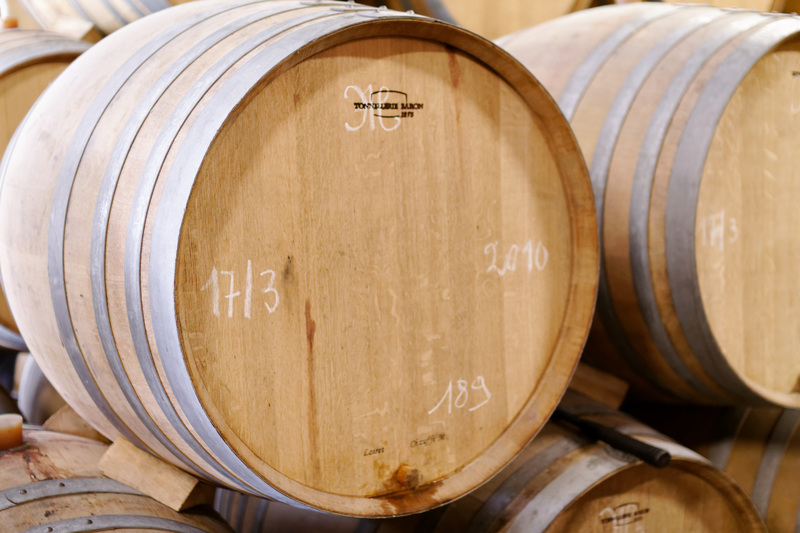The ever-lasting Christmas beer
In the early 17th century, walloon smiths were famous for their ironwork, and the Swedish kings therefore invited them to settle in Sweden. A substantial number did, but quickly found that they did not like the Swedish beer. Instead, they preferred the walloon type of beer, which from the description sounds similar to Flemish red or oud bruin. One style seems to have been "Maastrichts oud", which was lightly soured by cellaring in wooden barrels.
To satisfy their craving for walloon beer, the walloons started brewing their own beer. Out of this brewing quickly developed what seems to be a Swedish variation: hundred-year beer (hundraårig öl). This was a beer primarily made for the aristocratic owners of iron works or major mansions.
It was brewed the same way as the walloon beer, and then stored in big wooden tuns. After a few years, half the beer would be drained off and bottled, and a new batch would be used to fill up the barrel again. This would go on for, in quite a few cases, many decades. The barrel would never be emptied, so it could literally be said to be hundred-year beer, although obviously the beer from a century ago would be present only "in homeopathic concentration" as one source put it.

Walloon beer casks, Rebecq (at Tilquin) |
This may sound incredible, but there are in fact very good sources to underpin this story. One source from Finspåg in Östergötland writes about the 17th century walloon brewer Lina Goffin (Gauffin), who brewed "old ale for the master of the manor". Then, in 1760, in a description of Östergötland, another source writes of the famous beer tun called "uncle" (mor-bror), containing beer brewed in 1646 by one Lina Goffin. A quarter of it is still left, he writes, and nothing has been added since it was first brewed, "so that it is now a powerful medicine".
Another example is a letter, written by the manager of Söderfors Bruk in May 1873. The author managed the ironworks there from 1820 to 1868, and in all that time he took good care of a tun of hundred-year beer. He writes that it originally dates from 1794. The letter is written to say that he now donates this tun to his successors as managers, in the hope that they will "take good care of it" (emphasis in original), by adding freshly brewed beer every other year. He hopes the tun can be preserved "into the remotest future".
This type of beer became a Christmas delicacy, to be drank in small glasses like the noblest wine. And since it in some ways clearly lasted for centuries, I feel it justifies the title. An obvious question is of course when the tradition died out. That doesn't seem to be known. My source (a book from 1968, see below) writes that in the 1960s there were still families in central Sweden who had a tun in their possession. They would generally get help from local breweries, like Uppsala Bryggeri, to get new beer to add to the tun every other year.
A description of the brewing, written in 1952 and housed at the Nordic Museum in Stockholm, shows how the beer was brewed. Or rather, how it was brewed at Söderfors Bruk in the 1950s. Very likely it's been brewed in different ways at different times and in different places.

Stockholm Old Town at night |
60 kilos of malts were used to produce 75 liters of beer. The brewer would pour the unmilled malts into the mashtun, then crush them with the malt shovel against the side of the tun. As a result, the brewer would be covered in white malt dust and look like "a snowman." It was gradually mixed with cold water, then left for some hours. This must have caused lactic bacteria in the malts to sour the beer. Then 200 liters of boiling water would be poured onto the malts. Once the mash had settled, the watery part at the top would be taken off, boiled, and poured back. This was repeated 11 more times!
The wort was then boiled with 5 kilos of hops until the volume was reduced to the desired 75 liters. It was fermented with ordinary "brewery yeast" (not clear exactly what that means). After 24 hours of fermentation, 75 liters of old beer would be drained from the old cask and bottled, and the 75 liters of new beer added.
Now this sounds like a Christmas beer worth trying, but it seems the only way to do it is to go round the old manors outside Uppsala, knocking on the doors of the ones that have suspiciously big cellars.
Sources
My single source for this is Harald Thunæus's excellent book on Swedish beer history, published in 1968. I stumbled across it just a couple of days ago, and so haven't had time to track down his references. All of the sources above are quoted in the book. I did Google around to learn more, but found essentially nothing. The title is stolen from one of Thunæus's sources.
Update: From a Reddit comment I learn that this is what is known as solera.
Similar posts
Norwegian Ethnological Research
The definitive book on Norwegian farmhouse ale is Odd Nordland's "Brewing and beer traditions in Norway," published in 1969
Read | 2014-09-15 15:38
The juniper mystery
When I started looking at farmhouse ale back in 2010, one of the first things that struck me was that nearly everyone seemed to be using juniper
Read | 2017-02-02 09:43
Comments
Jeremiah Q - 2014-12-21 20:42:09
Great read! I know that the Brewery uses the solera method with their yearly anniversary blends.
Hope more and more people begin to use this with time.
Amos - 2014-12-24 12:07:24
English manor brewers used a similar technique that they called "marrying ale". This post from Ron Pattinson's blog might be of interest to you: http://barclayperkins.blogspot.com/2011/04/stock-ale-in-early-19th-century.html
Lars Marius - 2014-12-25 06:40:43
@Amos: That "marrying ale" technique sounds interesting, and very similar.
One thing I took away from this story and reading Country House Brewing in England, by Pamela Sambrook, is that one should perhaps think of manorial brewing as another substrand of brewing, in between farmhouse brewing and commercial brewing. It's curious that English manorial brewers should have hit upon something so close to the same technique used by Swedish manorial brewers.
Ben - 2014-12-28 16:02:38
I recently ran across this article: http://www.theawl.com/2014/12/last-years-punch
It reminded me of this post beacuse of both the ever-lasting/solera and Christmas themes
Lars Marius - 2014-12-28 16:08:49
@Ben: Interesting. It's effectively the same thing, although of course keeping it frozen and not using a wooden container means the year in storage has little effect on the flavour.
Dan Pixley - 2020-07-05 04:55:50
Regarding the update of saying this is a "solera", it is a "solera" only in the sense of American brewers recently borrowing the term from sherry, but this brewing process doesn't really reflect the solera process of sherry. The wine world uses a term called "perpetual blend" for this.
http://www.milkthefunk.com/wiki/Solera#Claims_of_Misuse_of_the_Traditional_Meaning